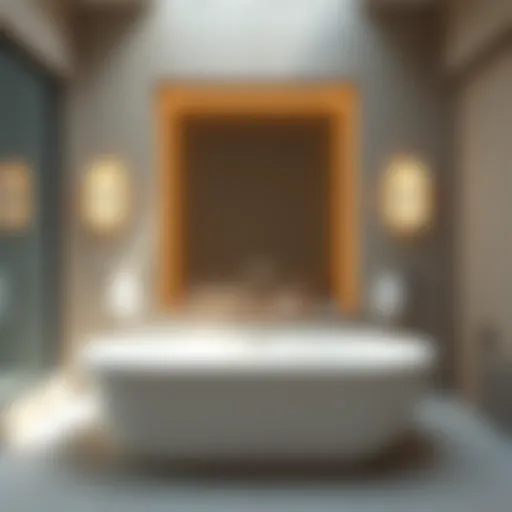Exploring Color and Geometry in Bath Rugs
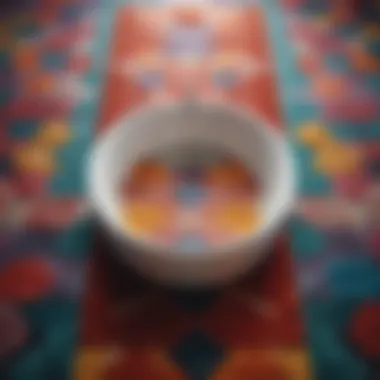

Intro
The selection of bath rugs is often overlooked in the design of a bathroom, yet the intertwining of color and geometry in these elements can significantly influence the ambiance of the space. A bath rug can serve not only practical functions but also as an artistic statement that rejuvenates the aesthetic of a room. This article focuses on how color schemes and geometric designs can enhance both the visual appeal and the functionality of bathroom spaces. By understanding the latest trends, benefits, and care advice, homeowners can make informed choices that reflect their personal style.
Design Inspirations
In the realm of bath design, contemporary inspirations merge aesthetics with practicality. The latest trends lean towards minimalism and sustainability but remain bold through color choice and geometric patterns that are pleasing to the eye. Incorporating such designs can turn an ordinary bathroom into a serene sanctuary.
Latest Trends in Bath and Bedroom Design
Current trends emphasize a seamless flow of color and geometry, creating a cohesive space. Here are some key elements:
- Natural Materials: Rugs made from organic fibers like cotton and jute bring warmth to the design.
- Geometric Patterns: Shapes such as hexagons and chevrons are favored for their striking visuals and modern appeal.
- Monochromatic Schemes: Neutral color palettes are accented with pops of vibrant colors, allowing for versatility.
These trends demonstrate a shift towards creating calm yet visually stimulating environments. They align with a growing desire for spaces that promote relaxation and a connection with nature.
Color Palettes and Themes
Understanding color theory is crucial when selecting a bath rug. Different colors evoke various emotions and can dramatically alter the perception of space. Homeowners should consider:
- Cool Tones: Shades of blue and green are calming and perfect for spa-like environments.
- Warm Tones: Reds, oranges, and yellows add energy and can make larger bathrooms feel more inviting.
- Contrasting Combinations: Pairing light-colored tiles with darker rugs can yield a striking visual contrast.
Such palettes can establish a theme for the entire bathroom experience, influencing mood and function alike.
"The right color and geometric pattern can transform a simple bath rug into a focal point of the bathroom design."
Functional Elements
While aesthetics are crucial, the functionality of bath rugs cannot be underestimated. They serve to provide comfort while enhancing safety in potentially slippery areas.
Space Optimization Tips
Many homeowners struggle with maximizing the utility of their bathroom spaces. Bath rugs, when placed strategically, can make areas feel larger or cozier depending on needs. Here are some tips:
- Size Matters: Choose rugs that fit your space proportionally to prevent overcrowding.
- Layering: Using multiple small rugs can create visual interest and allow for easier cleanup.
- Placement: Position rugs near sinks, tubs, and showers to ensure safety while enhancing aesthetics.
Multi-Functional Choices
Selecting bath rugs that serve multiple purposes can lead to enhanced efficiency in the bathroom. Consider:
- Anti-Slip Features: Ensuring rugs have non-slip backing increases safety.
- Quick-Drying Materials: Rugs made with microfiber or specialized quick-dry materials are ideal for maintaining cleanliness.
- Washable Options: Consider rugs that are machine washable for convenience.
These functional aspects not only serve a purpose physically but also contribute to a more organized and polished bathroom appearance.
Understanding Bath Rugs
Bath rugs play a critical role in the overall functionality and aesthetics of a bathroom. They provide a practical solution for wet feet after bathing, effectively absorbing moisture and preventing slips. Understanding bath rugs is fundamental when it comes to enhancing both safety and design within this space. The right choice of bath rug can complement the bathroom's decor while adding both comfort and warmth that many hard surfaces lack.
Functionality of Bath Rugs
At their core, bath rugs serve a basic yet vital function. They mitigate the risk of slips on wet surfaces, a common concern in bathrooms. They soften the impact of standing on hard flooring, making the space more inviting. Additionally, they help trap heat, making the bathroom feel more comfortable, particularly in colder months. It's essential to consider factors like absorbency, non-slip backing, and ease of cleaning when selecting a bath rug. A rug that can quickly dry and withstand frequent washing is ideal, ensuring its functionality over time.
Types of Bath Rugs
The selection of bath rugs is diverse, offering various materials that cater to different preferences and needs. Here are a few popular types:
Memory Foam
Memory foam bath rugs are known for their exceptional comfort. They conform to the shape of your feet, providing support that feels luxuriously soft. This makes them a popular choice among individuals looking to elevate their bathing experience. Memory foam rugs also often have non-slip backs, adding safety to their luxury. However, they can be more challenging to clean than other types, as they may require special care to maintain their shape and foam integrity.
Cotton
Cotton rugs are a classic option. They are highly absorbent, which makes them effective at soaking up moisture. The key characteristic of cotton is its breathability, contributing to a fresh environment in the bathroom. Cotton rugs are generally easy to wash, which adds to their practicality. However, they may not dry as quickly as synthetic options, making it crucial to choose a quality cotton rug that can withstand regular use without deteriorating.
Microfiber
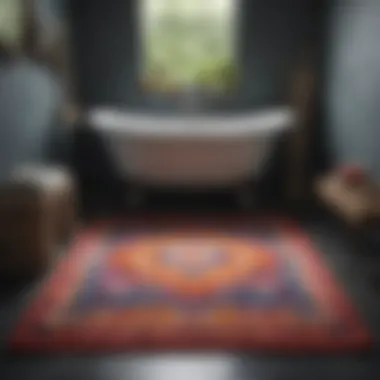

Microfiber bath rugs are celebrated for their quick-drying properties. The fine fibers absorb water efficiently, making them ideal for heavy-use bathrooms. One of the unique features of microfiber is its resistance to mold and mildew, which are common concerns in damp spaces. While microfiber rugs are incredibly practical, they can sometimes lack the aesthetic appeal of more traditional materials, depending on the design.
Shag
Shag rugs add a sense of luxury and warmth to bathrooms. Their plush texture offers a cozy feel underfoot, appealing to those who prioritize comfort. Shag rugs can also make a stylistic statement with bold colors and patterns. However, they can be harder to clean and maintain, as they tend to trap dirt and moisture within the fibers. This makes them less suitable for high-traffic areas without proper care.
Understanding the various types of bath rugs helps homeowners choose effectively. The right selection enhances both safety and comfort while contributing to the overall decor of the bathroom.
The Role of Color in Bath Rug Design
Color plays a pivotal role in bath rug design, serving both aesthetic and functional purposes. It enhances the overall ambiance of a bathroom and can influence mood and perception. Choosing the right colors for bath rugs can transform the space from ordinary to visually pleasing. Moreover, color can affect how individuals experience the room, hence making informed choices about hues is essential. This section examines color theory, psychology, and current trends that guide selections in bath rug design.
Color Theory Basics
Understanding color theory is vital for making effective design choices. At its core, color theory involves the relationship between colors, how they interact, and how they can complement or contrast each other. Primary colors are red, blue, and yellow. From these, secondary colors are derived by mixing primary ones. Tertiary colors result from blending primary and secondary colors.
The color wheel is a crucial tool in this context. It visually represents relationships and helps in selecting colors that can create harmony or tension in design. A well-thought color scheme can establish a unified look in a bathroom, ensuring that the bath rug supports the intended design theme rather than detracting from it.
Color Psychology and Mood
Color psychology explores how hues affect human behavior and feelings. For bath rugs, certain colors can induce particular moods, creating a sanctuary of relaxation or a vibrant space for energy.
Calming Colors
Calming colors, such as soft blues and greens, promote tranquility. Their gentle appearance contributes positively to the overall aesthetic of a bathroom, allowing for a sense of relaxation. Using calming colors is particularly beneficial in creating an atmosphere for self-care and rejuvenation.
One unique feature of calming colors is their ability to create an illusion of space. Light tones can make a small room feel larger. However, too much of these shades may render the space bland, which is a potential disadvantage in a vibrant home.
Energizing Hues
On the contrary, energizing hues include vibrant tones like bright yellows, oranges, and reds. These colors inject energy and warmth, creating a lively environment that can be quite engaging. They are particularly suited for spaces where one starts or ends their day, such as bathrooms.
The distinctive characteristic of energizing hues is their capacity to stimulate cognitive functions. This quality enhances the morning routine, encouraging one to start the day positively. The disadvantage can be an overwhelming effect if used excessively in smaller spaces, which can make these hues feel cluttered and chaotic.
Neutral Palettes
Neutral palettes involve earth tones and subdued shades, such as beige, taupe, and white. These colors serve as a backdrop that complements any design. They provide a clean and sophisticated look while maintaining calmness in the environment.
The advantage of neutral palettes lies in their versatility; they can adapt to changing trends without a complete redesign. They can pair gracefully with both bold and subtle colors. However, neutrals may sometimes lack personality unless paired with striking accents or textures, which might be seen as a limitation in more creatively inclined settings.
Trends in Color Choices
Color trends in bath rugs keep evolving, reflecting broader design movements and consumer preferences. Presently, there is a noticeable shift towards sustainable and organic colors, which often emphasize earthy tones and natural material finishes. Soft pastels and muted shades also remain popular, aligning with minimalist and zen-inspired aesthetics. Contrarily, jewel tones have come to the forefront in luxurious designs, offering richness and depth.
Homeowners should take note of these trends while considering personal preferences and existing bathroom decor. Staying informed about trends can assist in making choices that are both stylish and functional.
With the right application of color, bath rugs can effectively enhance the bathroom experience.
Geometric Patterns in Bath Rugs
Geometric patterns in bath rugs are essential in creating a dynamic space. They are not merely aesthetic choices; they also enhance the functionality and visibility of the bathroom area. These patterns can influence the overall atmosphere of the room and provide a sense of structure. The interplay between color and geometry can lead to intriguing designs, making the bath rug a focal point in the bathroom.
Benefits of Geometric Designs
Geometric designs offer several benefits. They can create visual interest, helping to distract from any less appealing features in the bathroom. They also serve to unify the various elements of the design, ensuring that the space feels cohesive. Moreover, geometric patterns can complement a wide variety of styles, from contemporary to traditional. Such versatility allows for broad personal expression in the selection of bath rugs, ensuring they meet specific taste and aesthetic requirements.
Geometric Shape Types
Circles
Circles in bath rugs introduce a sense of fluidity and movement. Their rounded form contributes to a softer, more inviting aesthetic. Circles can also create visual balance by contrasting against straight lines found in tiles or furniture. However, they may not always fit neatly into square or rectangular spaces, which can be a disadvantage when considering placement.
Triangles
Triangles add a modern touch to bathroom designs. Their angular nature can lead to more dynamic visuals and can evoke energy within a space. Triangular patterns can also work well with other shapes, enabling creative layering. The challenge with triangles may lie in their sharpness, which can sometimes overwhelm softer decor elements if not balanced properly.
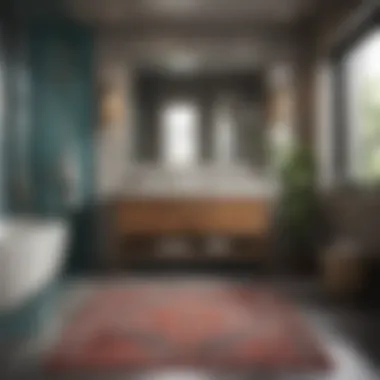

Squares
Squares offer stability and symmetry, providing a solid foundation in bath rug design. Their straightforward nature makes them easy to pair with other design elements. Furthermore, square patterns can enhance tidiness while reflecting a contemporary look. However, an overabundance of squares can potentially create a monotonous atmosphere, unless broken up by other shapes and colors.
Hexagons
Hexagons are increasingly popular thanks to their distinctive form. They present both elegance and complexity in design. Hexagonal patterns can merge well with mosaic designs, enhancing the intricacies of the bathroom decor. Their natural fit in tiling often complements existing elements well. However, hexagons may require more careful consideration in placement to avoid awkward visual gaps.
Mixing Geometric Patterns
Mixing geometric patterns demands a thoughtful approach. By combining shapes, one can create layers of interest and complexity. Balancing diverse shapes—like circles and squares—can lead to an intricately designed, yet harmonious space. It is crucial to maintain consistency in color to ensure that the mixed patterns do not clash. Careful selection of geometries can transform a simple bathroom into an engaging environment.
Harmonizing Color and Geometry
In the realm of bath rugs, the effective integration of color and geometric patterns is pivotal. It forms a visual dialogue that elevates the aesthetic appeal of a bathroom while ensuring functionality. When done well, these elements do not just coexist; they enhance each other, creating a harmonious environment.
The significance of harmonizing color and geometry lies primarily in the way these components interact. Colors evoke emotions, while geometric shapes create structure and balance. Together, they can define a space and influence the perception of size and ambiance in a bathroom. A well-thought-out combination can lead to a feeling of tranquility or stimulate energy depending on the desired outcome.
Selecting appropriate colors that complement geometric designs contributes to a cohesive look. For instance, soft pastels can soften the harsh lines of angular patterns, creating a gentle contrast that is visually pleasing. Alternatively, bold colors paired with intricate geometric layouts can create a striking focal point that draws attention without overwhelming the senses.
In practical terms, considering the existing color palette of a bathroom is essential. If the walls are painted in neutral shades, a vibrant geometric rug can serve as an anchor, add interest, and bring personality to the bathroom. On the other hand, a geometric design in similar tones can create a seamless transition, enhancing the overall flow of the space.
Creating Cohesive Designs
Creating cohesive designs involves a careful balance in color selection and the geometric patterns used. This requires an understanding of the fundamental principles of design, including simplicity, harmony, and contrast. A cohesive design is not merely a combination of colors and patterns but a reflection of a well-thought-out plan that aligns with the overall aesthetic of the home.
To achieve this, consider these approaches:
- Select a Dominant Color: Choose a primary color that matches or complements the bathroom fixtures and tiles.
- Use Monochromatic Schemes: Employ shades of a single color in different saturation levels to maintain a unified look while allowing for subtle variation.
- Limit Geometric Complexity: Begin with one geometric pattern, then layer with more subtle motifs to avoid overwhelming the space.
Achieving cohesion means also thinking about the functionality of the bathroom. A bath rug may have intricate designs, but it should remain practical for daily use, providing comfort and safety. This interplay of aesthetics and utility is where true design success lies.
Contrasting Colors and Patterns
Contrasting colors and patterns can add vibrancy and dynamism to a bathroom. While cohesion is important, intentional contrast can invigorate a space, bringing energy and excitement.
When employing contrasting colors:
- Use Bold Hues: Bright reds, deep blues, or bold yellows can dramatically shift the atmosphere, especially against lighter walls or softer tones in other elements.
- Balance with Neutrals: To prevent overwhelming the senses, balance bold contrasts with neutral shades like white, gray, or beige.
On the geometric side, consider:
- Different Shape Combinations: Contrasting circles with angular designs can create visual interest and intrigue. For example, a circular flower design set against rectangular tiles adds layers to the overall décor.
- Varying Scale: Mixing large patterns with smaller, more delicate ones can bring depth to the design. Larger shapes may provide a sense of space, while finer details offer texture and complexity.
Practical Considerations for Bath Rug Selection
When selecting bath rugs, several practical considerations play an essential role in their effectiveness and longevity. This section focuses on size and placement, material durability, and maintenance and care. Each element has its impact on how well the rug integrates into the bathroom environment, contributing both aesthetically and functionally.
Size and Placement
Choosing the right size for bath rugs is crucial. A rug that is too small may fail to offer the comfort and protection necessary from water spills. Conversely, a rug that is too large can overwhelm the space and create an awkward appearance. In general, the ideal size should accommodate the area where it will be placed while leaving a border of flooring visible around it.
Placement also requires thought. Common placements include directly in front of sinks, bathtubs, or showers. The location ought to maximize usability and safety. When laying rugs near wet areas, ensure they have non-slip backing to prevent accidents.
Material Durability
Material is a significant factor that affects not only the rug's appearance but also its durability and performance under frequent use. Common materials include cotton, microfiber, and memory foam. Cotton offers high absorbency but might wear out faster. Microfiber is known for rapid drying and resistance to staining, whereas memory foam provides excellent comfort but could require more frequent cleaning due to its density.
Investing in high-quality materials ensures that the bath rug withstands moisture, repeating foot traffic, and cleaning processes over time. Look for those features such as colorfastness and machine washabilit which increase the lifespan of the rugs.
Maintenance and Care
Regular maintenance is necessary to keep bath rugs in good condition. Most materials require machine washing, but it's advisable to check the care labels for specific instructions. When washing, avoid using bleach unless the rug is white or designed for it; bleach can compromise colors and fibers.
In addition to routine washing, airing the rugs after washing can prevent odors and mildew. Make it a habit to shake out the rugs regularly to remove dust and dirt.
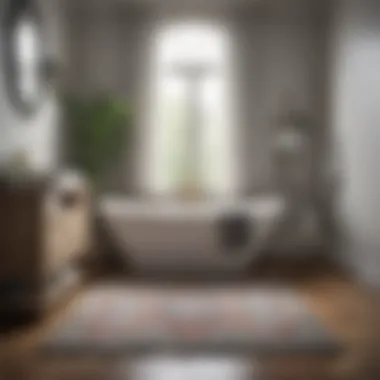

Caring for your bath rugs not only preserves their appearance but also contributes to a healthier bathroom environment. Keeping the rugs clean minimizes allergens and maintains a fresh atmosphere in your personal space.
Regular maintenance of bath rugs contributes to a healthier bathroom environment and prolongs their lifespan.
Understanding these practical considerations allows for a more informed selection process, ultimately enhancing the aesthetic and functionality of bathrooms.
Incorporating Bath Rugs into Design Themes
Incorporating bath rugs into design themes is crucial for achieving a cohesive and inviting bathroom space. This aspect goes beyond mere aesthetics; it creates an environment that reflects personal style and functionality. Bath rugs serve as both practical items and design elements that can enhance mood and theme. By understanding how to align bath rugs with existing decor, homeowners can optimize their bathrooms for both visual appeal and utility.
A variety of considerations can come into play when selecting bath rugs. Color and pattern combinations should complement the overall design, whether it be sleek modern lines or vibrant eclectic setups. Rugs are often the finishing touch that ties together different design elements. When executed correctly, the right rug can create a harmonious balance in the room, guiding the eye and facilitating a sense of order.
Modern Aesthetics
In a modern aesthetic, bath rugs often take minimalism to heart. Simplicity can wield a powerful impact when applied to rug selection. Fluid shapes and neutral colors typically dominate this style, emphasizing clean lines and spaciousness. Rugs with subtle geometric patterns can serve to break up large, blank spaces without overwhelming the eye.
The beauty of this approach lies in its understated elegance. For instance, choosing a pale gray memory foam rug may not only offer comfort but also enhance the fresh, clean look that modern bathrooms strive for. The material's softness adds an inviting feel underfoot, promoting satisfaction without compromising on sleekness.
Minimalist Design Approaches
Adopting a minimalist design approach with bath rugs often involves a careful selection process focused on function over excess. Ideal colors lean towards whites, blacks, or earthy tones, crafting a serene atmosphere. A single, well-placed, high-quality rug can stand as a focal point against a backdrop of sparse décor.
When striving for this type of look, it is essential to choose durable and easy-to-clean materials such as cotton or microfiber. This not only supports the minimalist ethos of efficiency but also ensures that the space remains free from clutter. Each item, including the rug, should possess purpose and value within the design philosophy.
Eclectic and Bohemian Styles
Eclectic and bohemian styles revel in a more playful approach to design. This channel allows individual expression to flow through color and pattern. Bath rugs can thrive in this setting, utilizing bold, vibrant hues and unique geometric shapes to create an eye-catching effect. Mixing and matching rugs with diverse textures adds layers to the space while reinforcing the overall theme.
When choosing rugs for this style, consider incorporating unexpected elements, perhaps a colorful shag rug paired with a decorative tapestry. The contrast fuels interest and generates a lively atmosphere in the bathroom. However, it is vital to maintain a sense of cohesion through similar color palettes or repeating patterns to prevent the room from feeling chaotic.
"The bath rug serves not just a practical purpose but can also enrich the aesthetic narrative of your bathroom."
In summary, the selection of bath rugs in relation to design themes can transform a mundane space into something captivating. Through proper alignment with modern, minimalist, or eclectic styles, these rugs are key to achieving that desired atmosphere. Each choice, grounded in both practicality and personal style, will enhance the functionality and visual quality of the bathroom.
Case Studies of Color and Geometry in Bath Rugs
The exploration of case studies offers essential insights into the practical application of color and geometry in bath rugs. These examples not only demonstrate aesthetic choices but also highlight the impact of well-considered designs on bathroom spaces. Effectively, case studies provide a framework for understanding how individual design decisions can resonate throughout an environment, influencing mood and functionality. They allow homeowners to visualize various combinations of colors and shapes, enhancing their understanding of effective design principles.
Innovative Bathroom Transformations
Innovative bathroom transformations often showcase how integrating specific colors and geometric patterns in bath rugs can dramatically uplift a space. Consider a case where bright, geometric-printed bath rugs are used in conjunction with muted wall colors. This creates a focal point in the bathroom, drawing the eye towards the rug while elevating the overall design aesthetic.
Additionally, another example involves utilizing a minimalist approach – simple, monochrome bath rugs paired with modern fixtures can create a unified appearance. These choices reflect a trend where simplicity meets functionality. When reviewing these transformations, the interplay between color vibrancy and geometric shapes becomes a crucial element in achieving a harmonious design.
The importance of texture cannot be overlooked either. A soft, plush shag rug can add depth to a bathroom while contrasting with sleek tiles, making the space feel inviting without overwhelming it. Overall, such transformations highlight how understanding the relationship between color and geometry can facilitate a visually appealing environment.
Contemporary Influences
Contemporary design is significantly characterized by its focus on bold choices. Recent influences in bath rug design stress an increased acceptance of experimental shapes and color combinations. For example, the use of angular shapes along with bright colors can reflect a modern aesthetic that resonates with youth culture.
Moreover, social media platforms like Instagram serve as a source of inspiration for many individuals looking to revamp their spaces. Trending designs often feature rugs with abstract geometric patterns, merging various colors. This showcases a departure from traditional subdued colors, marking a shift towards expressions of personality and identity through decor.
Furthermore, trends demonstrate that natural materials like cotton and eco-friendly designs are becoming popular among homeowners. These contemporary influences advocate for sustainable practices, encouraging the selection of bath rugs that are both stylish and environmentally friendly.
Final Thoughts
The Importance of Thoughtful Design
Thoughtful design in bath rugs transcends beyond just surface aesthetics. Each choice made in the selection process plays a significant role in the overall perception of the bathroom. Color selection can evoke various emotions and set the right mood, whether it is tranquility or vibrancy. A strategically chosen geometric pattern can add depth and dimension, making a bathroom feel larger or more intimate.
- Mood Enhancement: Colors influence mood. For instance, cool blues and greens can promote relaxation.
- Spatial Awareness: Geometric shapes can alter how space is perceived. Large patterns can make a room feel more expansive, while intricate designs lend a cozy feel.
- Synergy with Other Elements: Thoughtfully designed rugs complement tiles, fixtures, and other decor. Ensuring harmony among these elements can elevate design cohesiveness.
rug design is more than just function; it’s about creating an experience.
Future Trends in Bath Rug Design
Looking ahead, bath rug design is poised for exciting developments. The fusion of technology with textile design allows for more innovative patterns and sustainable materials. Homeowners now seek not only beauty but also functionality in their selections, reflecting a broader trend towards conscientious consumption.
- Sustainability: Demand for eco-friendly materials will likely grow, with brands focusing on renewable sources and organic fabrics.
- Smart Textiles: Rug technology may enhance safety features, like slip-resistance or even moisture-wicking, enriching the user experience.
- Customization: Consumers may begin to expect more personalized aesthetics, with options to choose colors and patterns that reflect their unique tastes.
Incorporating these trends will enrich how bath rugs are perceived and utilized in home design. Continued exploration into the relationship between color, geometry, and practical use will reveal even deeper connections to individual spaces.













